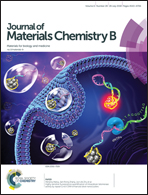Self-assembled RNAi nanoflowers via rolling circle transcription for aptamer-targeted siRNA delivery†
Abstract
To deliver siRNA efficiently, prevailing conventional lipid or polymer encapsulation often needs multi-step compounding methods, which may inevitably introduce cationic or other components and may lead to cytotoxicity or an immune response. Herein, we present a novel enzymatic synthetic approach to produce tumor-targetable RNAi nanoflowers. The RNAi nanoflowers are mainly composed of multiple tandem copies of siRNA precursors by rolling circle transcription (RCT), and produce large amounts of siRNA to silence Bcl-2 gene expression after cellular uptake, which can overcome the problem of low loading capacity. In particular, the RNAi microspheres (RNAi-MS) were condensed into nanosized complexes (RNAi nanospheres, RNAi-NS) by cholesterol-modified DNA strands without the assistance of polycationic agents. RNAi-NS are entirely composed of nucleic acid, giving them lower cytotoxicity and immunogenicity, which can be caused by synthetic polycationic reagents. In addition, the RNAi nanoflowers can also integrate DNA aptamers that bind specifically to target membrane proteins for cell-targeting. Therefore, thousands of copies of siRNA will be delivered to cells specifically, and this RNAi nanoflower system will have great potential for siRNA delivery and biomedical applications.



 Please wait while we load your content...
Please wait while we load your content...